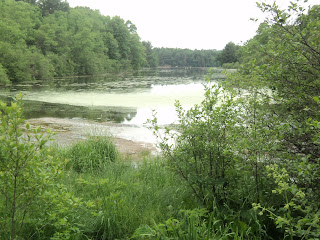Hike Location: Buckhorn State Park
Geographic Location: southeast of Necedah, WI (43.92785, -90.01368)
Length: 3 miles
Difficulty: 3/10 (Easy/Moderate)
Date Hiked: June 2018
Overview: A fairly flat loop through a sandy-dirt oak
savannah.
Park Information: https://dnr.wisconsin.gov/topic/parks/buckhorn
Directions to the trailhead: From Necedah, take SR 21
east 1 mile to CR G and turn right on CR G.
Drive CR G 8.6 miles through several 90-degree turns to the state park entrance
on the left. Turn left, pay the large
entrance fee, then follow the park road 1.7 miles to its end at 36th
Street. Turn right on 36th
St. and drive 0.5 miles to the south parking lot access road on the left. Park in the south parking lot.
The hike: Occupying
a large peninsula in the Wisconsin River’s Castle Rock Lake, Buckhorn State
Park and its adjacent wildlife areas consist of more than 8000 acres of former
timberland and farmland. Unlike many
other lakes in the area, Castle Rock Lake is man-made. The lake was created in 1947 by the
construction of Castle Rock Dam, a hydroelectric dam located a few miles south
of the park. Though it covers more than
16,000 acres, Castle Rock Lake is fairly shallow: its maximum depth is 30
feet. The park was established in 1974
when Wisconsin’s Department of Natural Resources purchased the land with the
goal of letting it revert to “unbroken wilderness.”
Aquatic
activities take center stage at Buckhorn State Park, as the park offers a
swimming beach, fishing, 5 boat ramps, canoe/kayak rentals, and a canoe trail
all on Castle Rock Lake. The park also
offers some picnic areas, a 58-site developed campground, and 50 cart-in
campsites. For hikers, 7 miles of trails
wind through the park, but the park is most famous for its oak savannah, which
is sometimes called its oak/pine barrens.
The route described here takes you through the savannah but also
explores the shores of Castle Rock Lake, thus letting you sample everything the
park has to offer.
 |
| Trailhead at south parking lot |
Start at
the northeast corner of the parking area where the two-track dirt/gravel trail
heads into the woods. A brown sign for
campsites 4-7 and 13-15 stands here, and a fleet of wheelbarrow-like carts awaiting
use by cart-in campers sits near this trailhead. Though no signs on the ground indicate such,
the park map calls this trail the Central Sands Nature Trail. An interpretive sign tells about Glacial Lake
Wisconsin, which deposited the oak/pine barrens’ sandy soil here near the end
of the most recent ice age.
 |
| Wooden bridge over marsh |
After
crossing a wide wooden bridge over a wooded marsh, the Central Sands Nature
Trail forks to form its loop. For no
particular reason, I chose to turn right here and hike the loop
counterclockwise. The trail heads south
with the wetland on your right. Bugs
will be bad here during the warmer months due to the wetland, but they will
relent when you get into the drier barrens later in this hike.
 |
| Castle Rock Lake |
At 0.35
miles, you get your first view of Castle Rock Lake just before you reach a
trail intersection. The Central Sands
Nature Trail turns left here to form its short loop, but this hike continues
straight to begin the Turkey Hollow Trail.
In short order you pass cart-in campsites 13, 14, and 15, all of which
offer nice lakeside locations.
0.6 miles
into the hike, the spur trail to campsites 4-7 exits right. Angle left to continue the Turkey Hollow
Trail, and in a few hundred feet you transition from the lakeside forest to the
oak/pine savannah. The character of the
hike now completely changes from a wooded, marshy, lakeside ramble to a sunny,
sandy, savannah trek. Oak trees dot the
landscape, and some sun protection might be in order if you burn easily. Also, hunting is allowed in this part of the
park, so wear bright orange in season to avoid accidents.
 |
| Entering the oak savannah |
Near 1
mile, turn right at the signed trail leading to the Partridge Trail. Note that continuing straight on the Turkey
Hollow Trail here would shorten the hike by about 1 mile. After a brief eastward stint, you intersect a
central access road where you need to turn right. Cut logs were piled up here on my visit,
likely an effort to keep the oak savannah a savannah by removing unwanted
vegetation.
At 1.3
miles, continue straight where the spur trail leading to campsites 17-19 exits
right. Shortly thereafter, take a sharp
left to begin the Partridge Trail; the route going straight is signed as one of
many non-trail service roads. The wide
grass/dirt trail heads northeast through more grassy and brushy oak savannah.
 |
| Hiking the Partridge Trail |
At 1.8
miles, signs direct you to turn left where another service road continues
straight. After crossing the central
access road again, you need to turn right at 2.3 miles to head back to the
Central Sands Nature Trail. Some pine
trees join the forest mix here. Upon
reaching the Central Sands Nature Trail, turn right again to begin the final
segment of our loop.
 |
| Back in the forest |
Bugs make
their return as you leave the savannah and re-enter the forest. Wetlands appear beside the trail, and the
park road lies through the trees on your right.
Just shy of 3 miles, you close the loop.
Angle right to recross the bridge, return to the parking lot, and
complete the hike. If you want to spend
more time in or learn more about the oak savannah, the short 1.5 mile Oak
Barrens Nature Trail you pass on the main park road out provides a good
opportunity to do so.

































